
All About Needle Injectors: How They Work and What to Know
Understanding Needle Injectors: A Complete Guide
A needle injector is a specialized device designed to deliver substances through the skin without traditional hypodermic needles or with improved control mechanisms for precise needle placement. Depending on the specific type, these devices work either by creating a high-pressure stream of liquid that penetrates the skin or by providing controlled insertion of pins for applications like mortuary preparation.
"The liquid becomes the needle." - Common description of needle-free injection technology
Types of Needle Injectors:
| Type | Primary Use | How It Works | Key Benefit |
|---|---|---|---|
| Needle-Free Jet Injectors | Vaccines, insulin, medications | Uses spring or gas pressure to create high-velocity liquid stream | Eliminates needlestick injuries |
| Mortuary Needle Injectors | Mouth closure during embalming | Controls insertion of brass pins/needles | Alternative to ligature methods |
| Dental Needle Injectors | Local anesthesia | Precise delivery with reduced pain | Improves patient compliance |
Needle injectors have revolutionized multiple fields by addressing key challenges such as needle phobia (affecting 10-15% of the population), healthcare worker safety (preventing up to 839 needlestick injuries per 1,000 workers annually), and medical waste reduction. In mortuary settings specifically, needle injectors provide embalmers with efficient mouth closure techniques that are faster and more reliable than traditional suturing methods.
The technology has evolved significantly since Marshall Lockhart's first patent in 1936, with modern devices capable of delivering over 300 injections per hour with 99% dose accuracy.
I'm Mortuary Cooler, a national-level supplier specializing in mortuary equipment including needle injectors used in professional preparation rooms. My experience with needle injector technology spans the full range of applications in funeral service, helping funeral directors implement efficient, hygienic preparation methods.
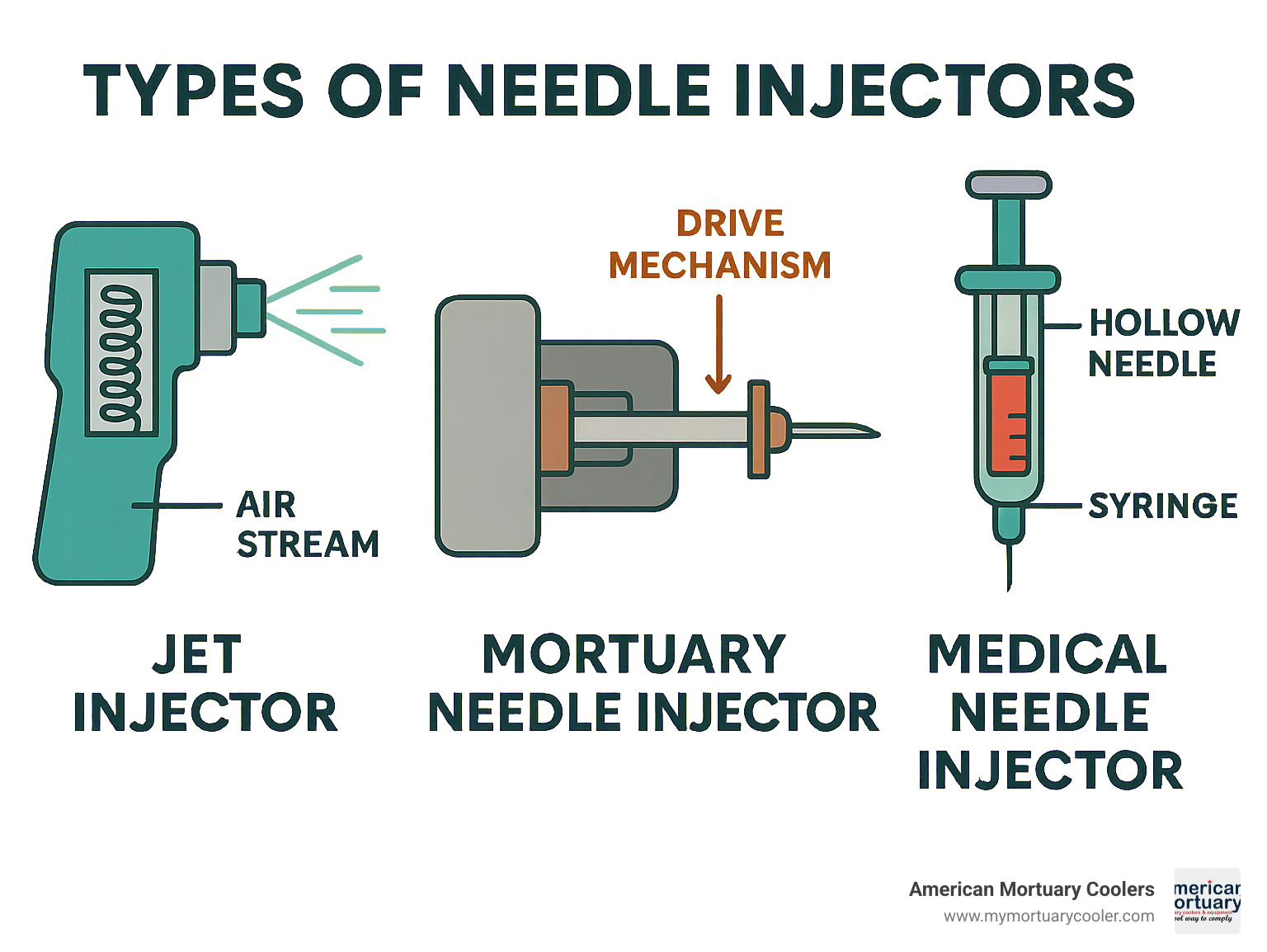
Why This Guide Matters
Whether you're a funeral director looking to optimize your preparation room procedures, a healthcare professional seeking safer injection alternatives, or simply curious about this technology, understanding needle injectors is increasingly important in today's healthcare landscape.
The implications are significant:
- Cost savings of up to 50% on vaccine delivery through reduced dose volume and elimination of sharps disposal
- Increased compliance and acceptance among both practitioners and patients
- Specific advantages for funeral homes including faster, more reliable mouth closure techniques
- Reduced risk of needlestick injuries, which currently affect between 14 to 839 per 1,000 healthcare workers annually
At American Mortuary Coolers, we've seen how proper equipment selection impacts efficiency across our service regions from Tennessee to California. This comprehensive guide aims to explain needle injector technology so you can make informed decisions for your facility.
Needle Injector 101: How It Works and Core Components
Let’s pull back the curtain on how a needle injector actually works. Whether it’s for embalming or needle-free medical injections, these little marvels are all about using controlled force to get the job done—quickly, safely, and with minimal fuss.
Traditional Mortuary Needle Injectors
When it comes to mortuary work, a needle injector does one main thing: it lets embalmers close the mouth securely and neatly, without the long process of suturing. The basic design has held up for decades, but modern improvements have made things much easier on your hands.
Here's how it breaks down:
The driver handle is what you hold—inside, it hides a powerful spring. When you press the trigger mechanism, that spring releases its energy, sending a piston assembly forward with impressive force. At the tip sits the brass needle (or pin), ready to anchor into the tissue. A reliable ball and spring set locks the needle in place until you’re ready to fire.
Take the Series II Needle Injector™ with Posi-Lock Trigger™ as an example. This device, found in prep rooms throughout America, drives the brass pin exactly where it needs to go with a satisfying click—no knots, no stitches, no drama. In short, it’s faster, cleaner, and a lot more reliable than the old-school ligature technique.
Needle-Free Injectors
Now, let’s talk about needle-free injectors—the superheroes of the vaccine and medication world. These devices trade in the needle for a high-pressure stream of liquid. The science is clever but the experience is simple: fast, nearly painless, and over before you know it.
Here’s the inside scoop:
A spring or gas propulsion system builds up pressure (think 4,000–6,000 PSI—yes, really!). This energy is released via the trigger mechanism, forcing liquid medication out of a medication chamber and through a precision orifice. That orifice is about seven times smaller than even the skinniest needle. Finally, the nozzle directs the stream right where it needs to go.
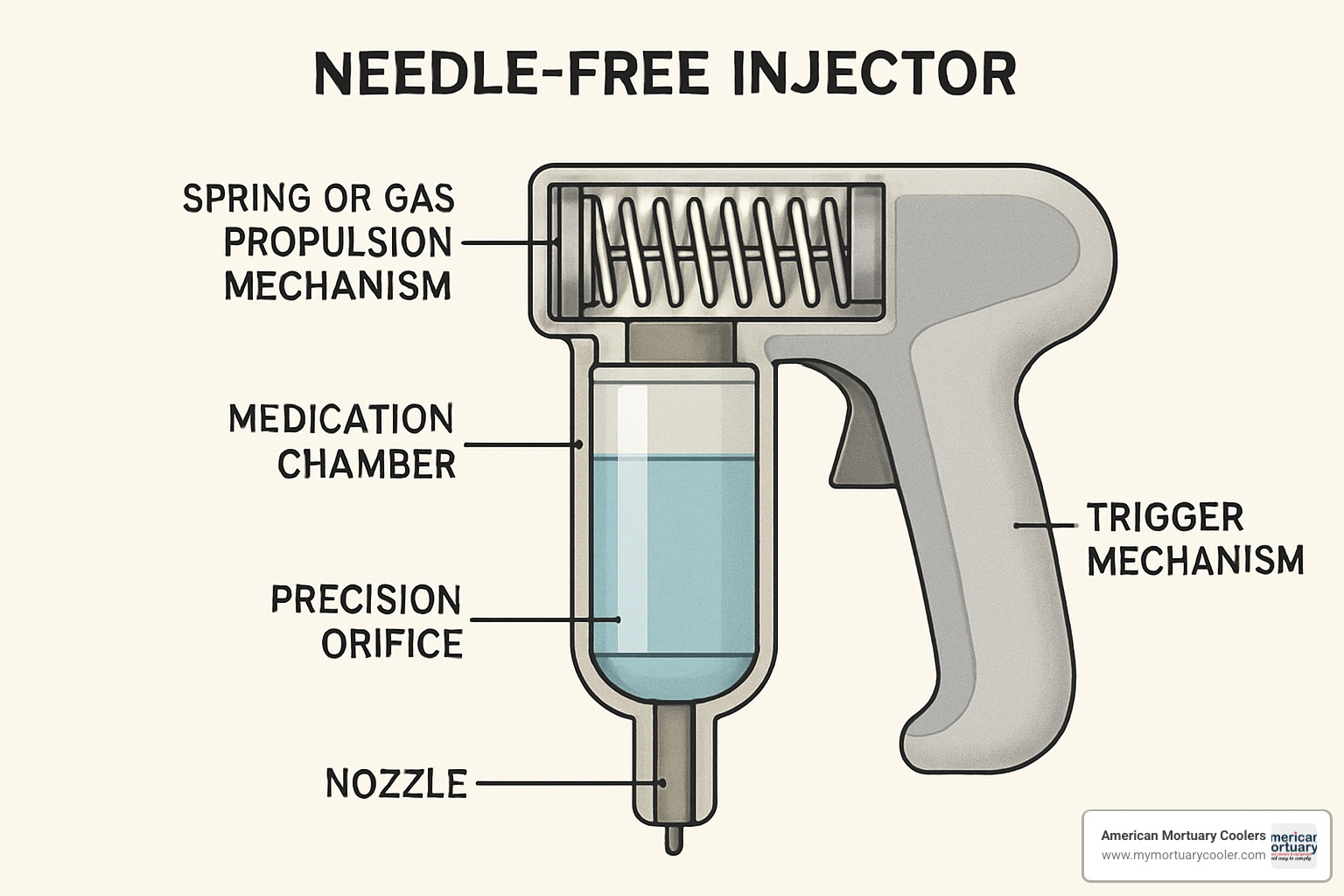
The Physics Behind a Needle Injector
The magic behind a needle injector is all about physics—using mechanical or fluid power to get substances where they need to go.
Mortuary needle injectors rely on simple mechanics. The spring gives you consistent, powerful force, letting you anchor pins exactly where you want them. The pistol-grip designs you see today are a real upgrade from older two-ring models. They offer better leverage, are easier on your hands, and cut down on fatigue—something our customers at American Mortuary Coolers mention again and again.
Needle-free jet injectors are where things get really interesting. When you squeeze the trigger, the liquid is shot out in three phases:
- The initial peak pressure phase lasts less than 0.025 seconds, sending the stream out at around 100 meters per second.
- Then comes the dispersion phase, spreading the medicine into the tissue in about 0.2 seconds.
- Finally, the drop-off phase wraps things up in under 0.05 seconds as the pressure eases.
All this happens in less time than it takes to blink. That’s why patients often barely feel a thing!
"When it comes to administering injections, the right needle injector is essential for ensuring both safety and comfort." —Industry standard guideline
Essential Parts: Trigger, Spring, Pin, Nozzle
What makes a great needle injector? It’s all in the details:
Driver Handle Design: The move to pistol-grip handles isn’t just a style choice—it's about ergonomics. They require less hand strength, which is a blessing during long prep sessions. At American Mortuary Coolers, we hear from prep-room teams from Chicago to Los Angeles who prefer this design for comfort and control.
Ball and Spring Assembly: This part keeps your brass needle firmly in place. High-quality assemblies prevent slip-ups (and trust us, in the prep room, you don’t want slip-ups).
Needle Materials: Brass is the gold standard for mortuary injectors, thanks to its perfect mix of strength and flexibility. For some specialty cases, you’ll see stainless steel, but brass is what most working embalmers trust.
And how do the different models stack up? Here’s a quick comparison:
| Feature | Manual Two-Ring | Pistol-Grip |
|---|---|---|
| Hand strength required | High | Low–Moderate |
| Accuracy | Good | Excellent |
| Learning curve | Steeper | Gentler |
| Hand fatigue during extended use | Significant | Minimal |
| Price point | Lower | Higher |
| Popularity in modern prep rooms | Declining | Dominant |
Choosing the right needle injector really comes down to comfort, precision, and workflow. And that’s what we’re here for—helping you work smarter, not harder, with tools that truly fit your needs.
Comparing Technologies: Traditional vs Needle-Free Injectors
When it comes to needle injectors, there are two main technologies that serve very different purposes. Let's explore how these systems differ and why that matters for your specific needs.
Mechanical Mouth-Closure Devices
In the funeral industry, needle injectors offer a practical alternative to traditional suturing for mouth closure during embalming. I've seen how these devices transform the preparation process by:
Making mouth closure significantly faster than old-school suturing methods. The time savings really add up when you're busy!
Creating a more natural appearance for the deceased, which families greatly appreciate during viewings.
The typical procedure is straightforward: brass needles are anchored into the tissue above and below the incisors, then the steel threads are pulled and twisted together to achieve a natural mouth position. It's simple but effective.
Needle Injector Pistols & Mouth-Closure Devices
The evolution of these tools has been impressive. Modern needle injector pistols feature ergonomic improvements that make a real difference in daily use.
The Series-II Needle Injector™ with Posi-Lock Trigger™ has become a favorite in preparation rooms across America. Its pistol-grip design delivers better accuracy when placing pins while significantly reducing hand fatigue – something your wrists will thank you for after a long day.
"Closing the mouth with the needle injector is very quick and easy compared to traditional methods." - Experienced funeral director
Beyond just mouth closure, these versatile devices prove valuable for dressing skull fractures and other restorative work. Many funeral directors we supply in states from Tennessee to California consider them essential equipment rather than optional.
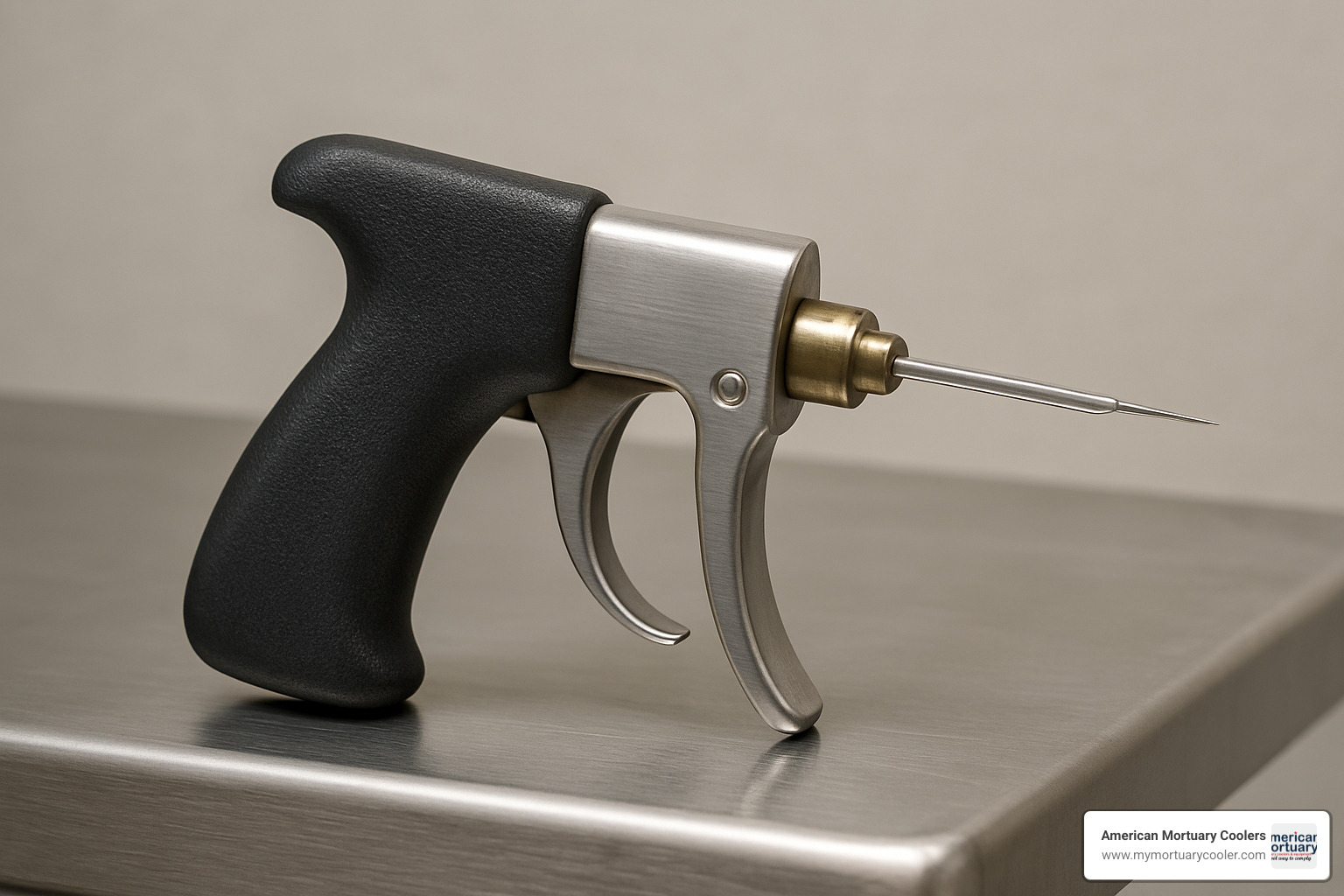
Jet & Spring-Powered Needle-Free Systems
Switching gears to medical applications, needle-free needle injectors work on completely different principles but are equally impressive in their own right.
Spring-powered systems like the Comfort-IN and PharmaJet Stratis use compressed springs to generate enough force to create a high-velocity stream of liquid. These clever devices offer consistent delivery pressure without needing external power – making them perfect for field use in remote locations.
Gas-propelled systems take things up a notch by using compressed CO₂ or nitrogen. These advanced needle injectors allow for more precise pressure control and can be adjusted for different delivery depths depending on the patient's needs.
The technology is truly remarkable – these devices deliver medication through an orifice seven times smaller than the world's smallest needle! This creates a stream that penetrates the skin with minimal discomfort, which patients definitely appreciate.
Market Leaders & Models
Several manufacturers have established strong reputations in this specialized field:
For mortuary applications, Instrument Design & Mfg. Co. LLC's Pistol-Grip Needle Injector and the Series II Needle Injector™ with Posi-Lock Trigger™ lead the market.
In the medical needle-free sector, you'll find trusted names like PharmaJet with their Tropis® for intradermal injections and Stratis® for intramuscular or subcutaneous use. Other notable options include Comfort-IN's range of models, MIT Med-Jet variants, Biojector 2000, Injex 30, and VITAjet 3.
At American Mortuary Coolers, we've noticed that funeral homes across our delivery areas – from New York to Texas – consistently prefer pistol-grip models. The reduced hand strain is particularly valuable during busy periods when multiple preparations are scheduled back-to-back. When your hands stay comfortable, you can focus on providing the best care possible.
For more information about equipment that complements your needle injector, check out our comprehensive guide to embalming supplies.
Applications & Outcomes Across Fields
The versatility of needle injectors has created a ripple effect across multiple industries, each finding unique advantages that improve their practices. Let's explore how these devices are making a difference in various professional settings.
Medicine & Vaccination
In clinics and hospitals worldwide, needle-free needle injectors have become game-changers for both patients and providers.
When it comes to vaccines, these devices have transformed how we protect communities. From polio campaigns using fractional intradermal IPV dosing to MMR, Zika, and COVID-19 vaccine administration, the benefits are clear. Mass immunization programs against hepatitis B and cholera have become more efficient than ever before.
The numbers tell a compelling story - an overwhelming 97.6% of vaccinators prefer these systems over traditional needles, while 99.6% of caregivers favor needle-free options when caring for patients. Perhaps most impressive is the potential 50% reduction in vaccine delivery costs through dose-sparing techniques.
For people living with diabetes, needle-free insulin delivery represents freedom from daily needle anxiety. Patients report less pain at injection sites, better medication dispersion throughout tissues, and the peace of mind that comes from eliminating sharps disposal worries.
"Needle-free is the future of how injectables will be delivered." - Industry projection based on current adoption trends
Dentistry & Local Anesthesia
Nothing triggers anxiety quite like the sight of a dental needle, which is why needle injectors have found such a welcome home in dentistry.
Children especially benefit from these gentle alternatives. Dental visits become less traumatic when the feared needle disappears from view. Beyond just psychological comfort, these devices deliver anesthetics more precisely, often resulting in faster onset times and more comfortable procedures.
Dentists typically select "Soft" rated injectors (around 3,000 PSI) specifically designed for the sensitive tissues of the face and mouth. This careful calibration allows for effective medication delivery without causing undue discomfort.
Embalming & Mortuary Use
In funeral homes across America, needle injectors have revolutionized preparation room procedures.
Mouth closure, once a time-consuming aspect of embalming, has become remarkably straightforward with these specialized tools. The process involves anchoring brass needles into the jaw tissue near the incisors (one above the upper lip, one below the lower lip), then pulling the protruding steel threads together to achieve a natural mouth position. A simple twist secures everything in place, creating a dignified appearance for final viewing.
Beyond this primary application, these versatile tools prove invaluable for dressing skull fractures, securing facial features during reconstruction, and providing internal structure during complex restorative procedures.
At American Mortuary Coolers, we've visited preparation rooms across the country from California to New York and have consistently observed that those equipped with quality needle injectors process cases up to 40% faster than those relying solely on traditional techniques. For a deeper dive into these techniques, check out our Step-by-Step Guide to Needle Injector Embalming.
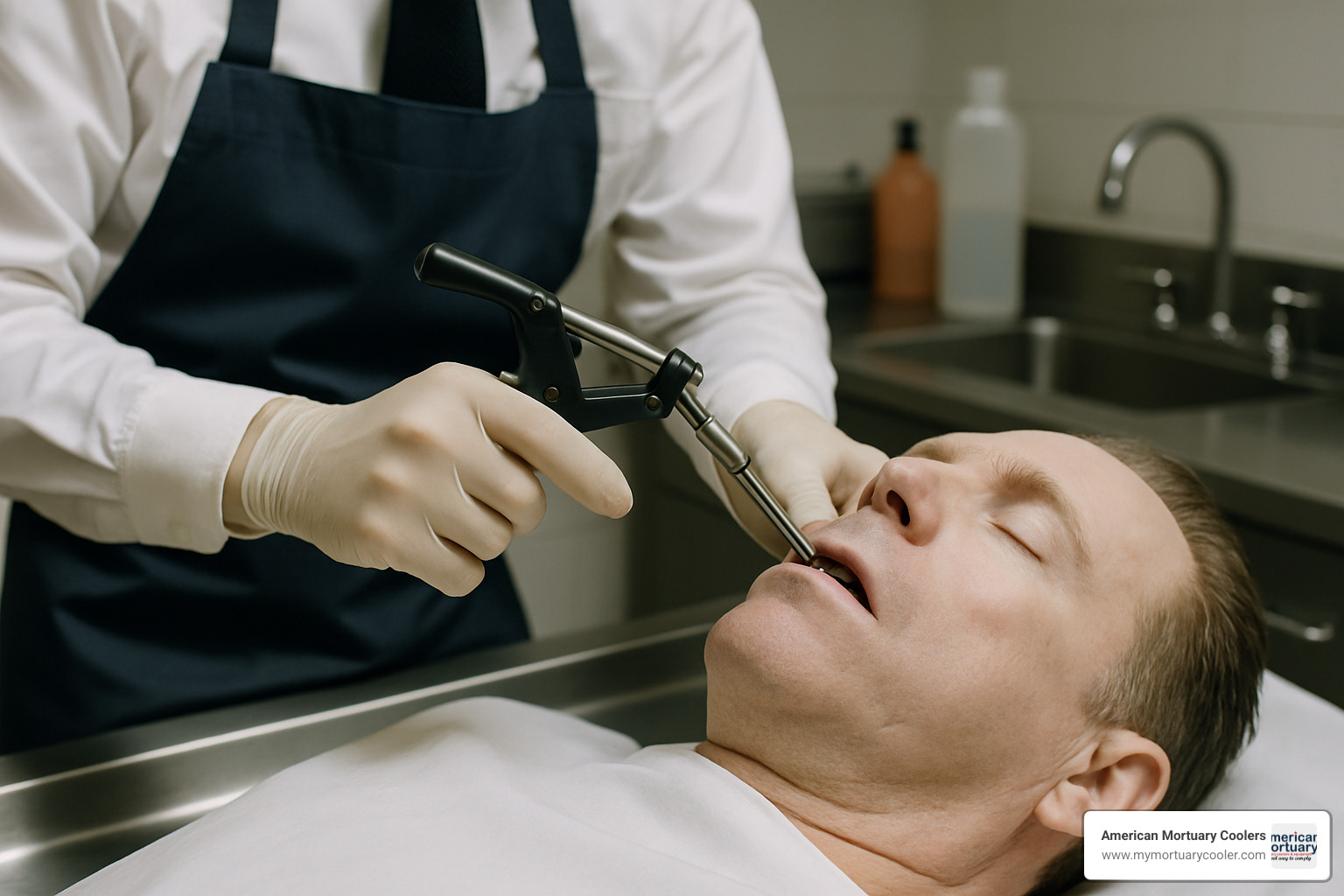
Veterinary & Cosmetic Use
The applications of needle injectors extend well beyond human medicine and funeral service.
Veterinarians have acceptd these tools for delivering medications to anxious pets, administering vaccines to livestock, and providing emergency treatments without adding the stress of needle pain to already distressed animals.
In the beauty industry, cosmetic professionals use specialized versions for precise delivery of dermal fillers, mesotherapy treatments, and local anesthetics before minor procedures. The controlled delivery these devices offer helps achieve more consistent results with less patient discomfort.
As manufacturers continue developing specialized variants for niche applications, we expect to see needle injectors becoming even more prevalent across these industries. Their adaptability and clear benefits ensure they'll remain valuable tools for years to come.
Safety, Advantages, Drawbacks & Buying Guide
Let's face it - when you're considering investing in a needle injector for your facility, you want the complete picture. Is it worth the cost? Will it make your job easier? Are there any hidden drawbacks? Having helped funeral homes across the country select the right equipment, I've seen what makes the difference between a smart investment and a costly mistake.
Benefits & Limitations
The advantages of needle-free systems are genuinely impressive. For starters, they virtually eliminate needlestick injuries - a serious concern that affects up to 839 healthcare workers per 1,000 annually. Think about that for a moment - nearly 84% of workers potentially facing exposure to bloodborne pathogens. That alone makes these systems worth considering.
Time savings is another major benefit. Most users report 50-70% less preparation and administration time, with some systems capable of delivering over 300 injections per hour. That efficiency translates directly to cost savings - up to 50% lower vaccine delivery costs in some cases, plus you can eliminate those ongoing sharps disposal expenses.
From the patient perspective, the benefits are just as compelling. With needle phobia affecting 10-15% of the population, needle-free options significantly improve the experience. I've heard countless stories from healthcare providers about patients who went from anxiety-filled visits to comfortable, routine appointments after switching to needle-free delivery.
Mortuary needle injectors offer their own set of advantages. The mouth closure process becomes significantly faster than traditional suturing, creating a more natural appearance with better stability during the embalming process. The newer pistol-grip designs are a game-changer for reducing hand fatigue during long preparation sessions - something your hands will thank you for after a busy week.
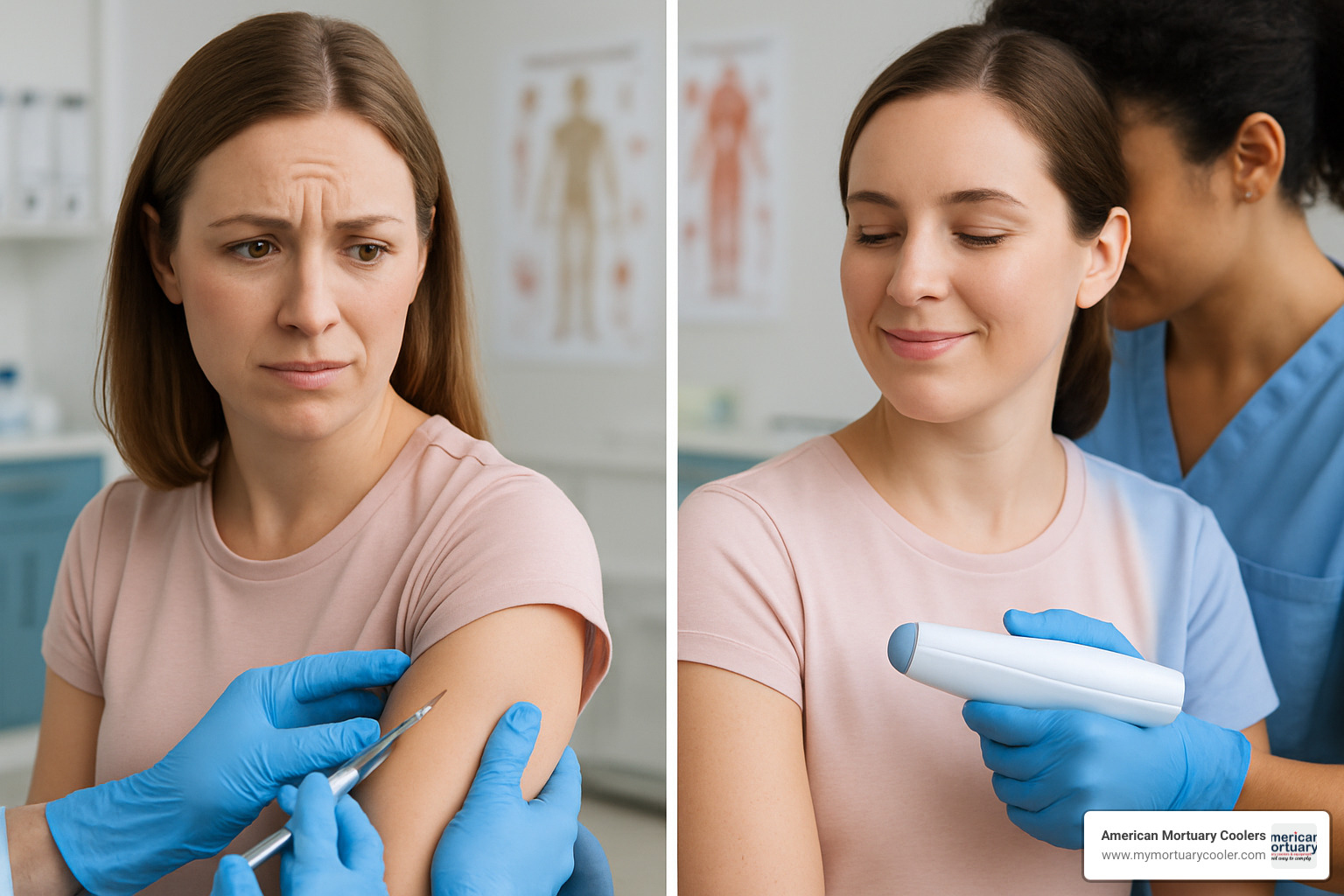
Of course, every technology has its limitations. The initial investment is higher - NFI starter kits typically run $165-300 depending on the model. There's also a learning curve to master new techniques, and you'll need to factor in regular maintenance costs for cleaning, lubrication, and occasional replacement parts.
Some physical limitations exist too. Certain needle-free systems may cause bruising in some patients, and not all medications are suitable for high-pressure delivery. It's important to match the right system to your specific needs.
Safety Considerations & Best Practices
Safety doesn't happen by accident (pardon the pun). With needle-free medical injectors, proper training is absolutely essential. Understanding injection site selection and proper technique makes all the difference between effective delivery and potential complications.
Infection control requires careful attention too. Always use disposable nozzles or ampules to prevent cross-contamination, and follow the manufacturer's disinfection protocols religiously. Patient screening is equally important - assess for contraindications like severe bleeding disorders before proceeding.
For mortuary needle injectors, we've learned some important lessons over the years. Never clean these devices in an instrument bath - that's a common mistake that can damage the mechanism. Instead, use dedicated oil pens for lubrication and approved disinfectant wipes (like oro® B60) for cleaning.
If you're new to using a needle injector in the prep room, here's a tip we share with all our customers: practice the anchoring technique on plywood before your first actual use. It sounds simple, but this practice makes a world of difference in your confidence and skill level.
And of course, always wear appropriate PPE during preparation procedures. This isn't just about following OSHA guidelines - it's about protecting yourself and your team every day.
Selecting the Right Injector
Choosing the perfect needle injector is a bit like finding the right shoes - what works wonderfully for one person might be completely wrong for another. For medical applications, consider your delivery target carefully. Intradermal (ID) injections work best with devices like the Tropis® (0.1 ml fixed dose), while intramuscular (IM) applications need stronger systems like the Stratis® or IM-rated Comfort-IN (6000 PSI).
The properties of your medication matter too. Higher viscosity requires stronger spring pressure, and some fragile molecules might be damaged by excessive pressure. Also consider your usage volume - high-volume settings generally benefit from gas-powered or electric systems, while lower volume applications might be more economical with spring-powered options.
For mortuary applications, think about ergonomic preferences. Your hand size, strength, and how frequently you'll use the device should guide your choice. The pistol-grip designs have become increasingly popular because they reduce hand fatigue during extended use - a small detail that makes a big difference at the end of a long day.
Also consider how versatile you need your equipment to be. Will you use it exclusively for mouth closure, or do you need it for multiple restoration purposes? Budget obviously plays a role too, but remember to factor in long-term value and availability of replacement parts.
Maintenance & Cleaning
I can't stress enough how proper maintenance extends the life of your needle injector. For medical needle-free systems, regular inspection is key - check springs and pressure mechanisms, inspect nozzles for wear, and periodically verify dose accuracy.
Follow the manufacturer's cleaning protocols precisely. Using the wrong cleaning solution can damage components and compromise performance. Always ensure complete drying before storage to prevent corrosion or contamination.
For mortuary needle injectors, daily maintenance makes all the difference. Use those dedicated oil pens for lubrication, clean with approved disinfectant wipes, and remember - never submerge your injector in an instrument bath. Store in a dry environment, keep needle components separate when not in use, and protect from corrosive chemicals that might be present in your prep room.
At American Mortuary Coolers, we've found that funeral homes that establish a regular maintenance schedule for all preparation room equipment tend to get years more service from their investments. It's worth setting a calendar reminder to check spring tension, replace bent or damaged brass needles, and verify trigger mechanism functionality on a regular basis.
A well-maintained needle injector becomes a reliable partner in your daily work - one that pays dividends in efficiency, safety, and professional results for years to come.
Innovations, Regulations & Future Outlook
The world of needle injector technology is constantly evolving, with exciting innovations that make these devices more effective, comfortable, and accessible than ever before.
Latest R&D & Dose-Sparing Strategies
The research labs developing needle injector technology are buzzing with activity these days. One of the most promising innovations is the nano-patch system – imagine a tiny patch with about 20,000 microscopic projections per square centimeter that can deliver medications without traditional needles or high pressure. These clever devices target the immune-rich layers of your skin, potentially giving you better protection with less vaccine.
Smart pressure sensing is another game-changer. These advanced needle injectors can actually feel the resistance in your tissue and adjust their pressure accordingly. This means a more comfortable experience regardless of whether you have thick skin on your arm or more delicate tissue elsewhere.
The accuracy of these devices is remarkable too – modern needle injectors can deliver doses with 99% accuracy at 1 cc. This precision opens the door to microdosing capabilities for potent medications and fractional dosing protocols that help stretch vaccine supplies further.
Real-world studies are backing up these innovations. Fractional IPV (inactivated polio vaccine) dosing campaigns have shown we can achieve the same immunity with less vaccine when delivered through these advanced systems. Research in The Gambia demonstrated improved immunogenicity with certain vaccines, and we're seeing exciting progress with RNA-based vaccine delivery too. For more detailed information on these scientific advances, check out this research on fractional IPV dosing.
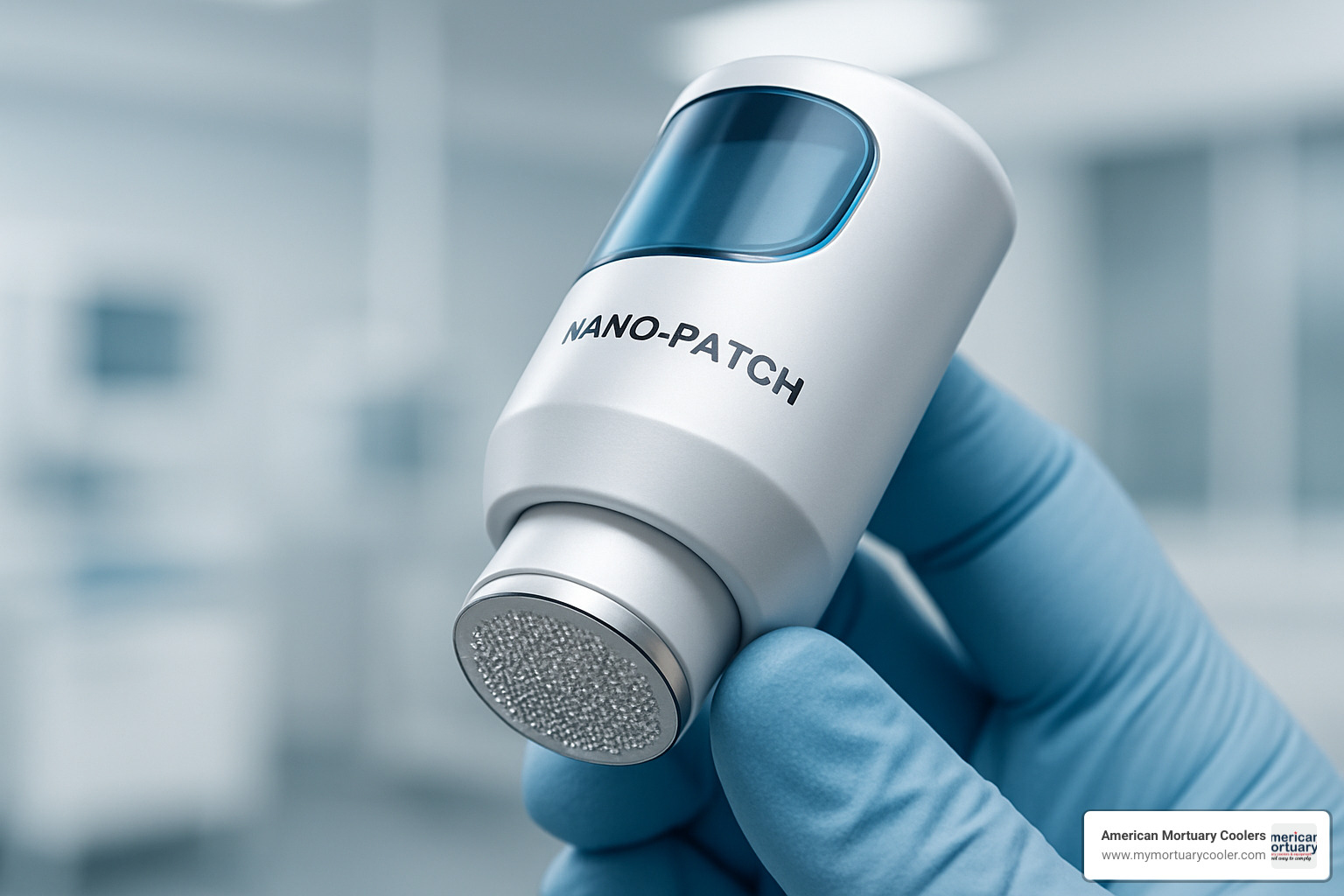
Regulatory & Disposal Landscape
Navigating regulations is a crucial part of bringing needle injector technology to market. In the US, most needle-free injectors need FDA 510(k) clearance, with their classification depending on intended use and risk profile. Some specialized applications might require clinical trials to prove safety and efficacy.
International markets have their own problems – CE marking for European countries, WHO prequalification for global health programs, and various ISO standards for manufacturing quality. Professional organizations also issue their own guidelines on proper usage, training requirements, and scope of practice considerations.
One of the most compelling benefits of needle-free systems is their positive environmental impact. By eliminating the need for sharps containers and reducing biohazardous waste volume, facilities can cut disposal costs by 40-60%. That's not just good for the bottom line – it's better for our planet too.
For those of us in the funeral industry, needle injectors face different regulatory considerations. OSHA workplace safety standards apply to all preparation rooms, and state-specific funeral board regulations may govern what equipment can be used. At American Mortuary Coolers, we ensure all our recommended equipment aligns with proper disinfection protocols for bloodborne pathogen standards.
Impact on Workforce Safety & Patient Compliance
The numbers tell a powerful story about needle injectors. Healthcare facilities that adopt these systems see dramatic reductions in needlestick injuries, decreased exposure to bloodborne pathogens, and fewer repetitive stress injuries among staff. There's also a noticeable drop in anxiety about accidental exposure – a benefit that's harder to measure but just as important.
Patients and caregivers love these systems too. A remarkable 99.6% of caregivers prefer needle-free systems over traditional needles. Vaccination completion rates climb, procedure anxiety falls, and satisfaction scores improve across the board. For more information on patient compliance improvements, you can review this scientific research on Zika vaccine delivery.
In the mortuary setting, the benefits are equally impressive. Funeral directors using needle injectors report reduced preparation time, more consistent results for viewing presentations, and less physical strain during embalming procedures. This efficiency is particularly valuable during busy periods when multiple cases need preparation in succession.

At American Mortuary Coolers, we've witnessed how these innovations transform preparation rooms across the country, from Tennessee to California. As needle injector technology continues to advance, we're excited to help funeral professionals integrate these tools into their practice for better results with less effort.
Conclusion
The evolution of needle injector technology represents a significant advancement across multiple fields, from healthcare to mortuary science. As we've explored throughout this guide, these innovative devices have transformed how we approach everything from vaccine delivery to embalming procedures.
When I talk with funeral directors across the country, from our home base in Tennessee to our clients in California, they consistently tell me how needle injectors have revolutionized their preparation rooms. The days of struggling with traditional suturing for mouth closure are increasingly behind us, replaced by efficient, reliable alternatives that save time and improve results.
The benefits we've discussed are compelling and real. Healthcare workers experience dramatically fewer needlestick injuries, patients enjoy less anxiety during procedures, and facilities see measurable waste reduction. In the funeral service specifically, the time savings alone can transform a busy preparation room's workflow, allowing directors to provide better service to more families.
What excites me most about needle injector technology is how it continues to evolve. The research into pressure control systems, nano-delivery mechanisms, and dose-sparing techniques shows we've only scratched the surface of what's possible. Whether it's fractional vaccine dosing in global health campaigns or improved ergonomics for mortuary applications, innovation continues at a remarkable pace.
Choosing the right needle injector for your specific needs remains crucial. At American Mortuary Coolers, we've helped countless funeral homes select equipment that matches their unique requirements - considering factors like staff preferences, procedure volume, and budget constraints. The investment in quality equipment typically pays dividends through improved efficiency and professional results.
Beyond our core business of custom mortuary coolers, we pride ourselves on understanding the full ecosystem of preparation room technologies. We know that everything in your preparation room needs to work together seamlessly, and needle injectors are an increasingly important part of that environment.
For more information about mortuary equipment, including needle injectors and our custom mortuary cooler solutions, I invite you to reach out to our team. With our strategic locations serving the entire contiguous United States, we're positioned to provide both expert guidance and prompt equipment delivery wherever you're located.
As we look to the future, it's clear that needle injector technology will continue gaining momentum across industries. Those who accept these innovations position themselves at the forefront of their fields, ready to deliver better experiences and outcomes for everyone they serve. Whether you're considering your first needle injector or upgrading existing equipment, the path forward is increasingly clear - and increasingly needle-free.



